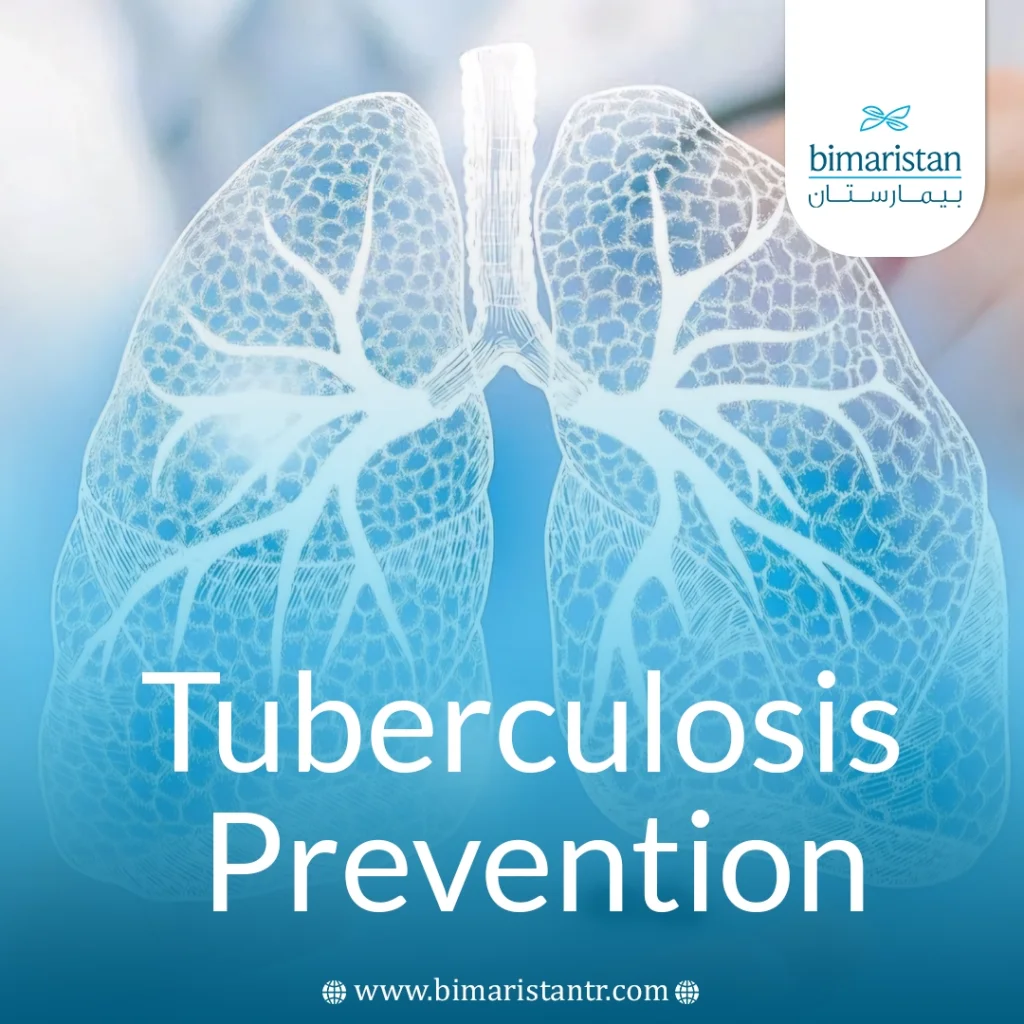Tuberculosis (TB) is one of the most common infectious diseases in the world, yet most cases are preventable through awareness and adherence to preventive measures. Tuberculosis prevention is an essential step in reducing infection and minimizing the need for long and complex treatments.
Spreading health awareness and adopting preventive practices protect individuals and communities from the risk of infection and help build a safer, healthier environment. Prevention is not only a medical responsibility but a collective duty that limits the spread of the disease and ensures a TB-free future.
What is tuberculosis?
Tuberculosis is an infectious disease caused by the Mycobacterium tuberculosis bacteria that affects the lungs in most cases, but can spread to other organs such as the kidneys, brain, and bones. The infection is transmitted through the air when an infected person coughs or sneezes unprotected, and is easily inhaled by others. Although the disease develops slowly, it is still one of the leading causes of infectious death globally, making awareness and prevention a necessity to protect society and limit its spread.
Why is it important to prevent tuberculosis?
The World Health Organization (WHO) reports that by 2024, more than 10 million people will be infected with tuberculosis every year, and it is estimated that more than 60% of these cases could be prevented through the implementation of effective prevention strategies. Early immunization, early diagnosis, and preventive treatment of latent TB are all ways to reduce infection and mortality rates.
The benefit is not only for the individual but also for the entire community, as tuberculosis prevention in one person can mean protecting many people from the risk of infection. Investing in prevention is a smart move that reduces health and economic burdens and ensures a safer, TB-free future.
BCG vaccine and its role in tuberculosis prevention
Bacille Calmette-Guérin (BCG) is the only globally approved vaccine for tuberculosis prevention, a live attenuated vaccine developed from the Mycobacterium bovis strain that has been used since 1921. Administered in early childhood as part of national immunization programs in countries with high rates of tuberculosis, this vaccine provides effective protection for children against serious forms of the disease, such as meningococcal tuberculosis and disseminated tuberculosis.
The effectiveness of the vaccine is estimated at 80% during the first 15 years after vaccination, but its effect decreases with age, and its effectiveness varies between geographical regions due to the presence of other types of mycobacteria in the environment. Although it does not completely prevent infection, it significantly reduces the severity of the disease and its complications, and research is currently underway to develop new vaccines that are better able to protect adults from pulmonary TB infection as part of global efforts to achieve the goals of the End TB Initiative by 2035.

Daily tuberculosis prevention behaviors
Daily hygienic behaviors are the first line of defense against TB transmission, as the bacteria are easily transmitted through the air when coughing or sneezing indoors. Adhering to hygiene and proper breathing habits reduces the likelihood of infection and protects family members and close contacts. It is one of the most important daily preventive measures:
- Cover your mouth and nose when you cough or sneeze
- Open windows daily to optimize home ventilation
- Wear a mask in indoor and crowded places
- Wash your hands regularly and avoid sharing personal items
- Avoid close contact with infected people until the infection is over
People with active TB are advised to stay in well-ventilated areas during the first weeks of treatment, use N95 respirators, and avoid returning to work or school until recovery is confirmed. Adhering to these simple daily habits can help break the chain of infection and minimize the spread of the disease in the community.
Tuberculosis prevention in hospitals
Hospitals are one of the most vulnerable environments for the transmission of tuberculosis, so strict infection control protocols are in place. Prevention within hospitals relies on good ventilation and the use of negative-pressure chambers to isolate patients with active TB from other patients, limiting the spread of bacteria in the air.
Health workers are required to wear N95 masks while handling patients, while patients are required to wear a medical mask during examination or treatment, and health workers are regularly screened to detect any latent tuberculosis infection in its early stages. Adhering to these preventive measures within health institutions ensures the protection of medical staff and patients alike and prevents the formation of new foci of infection.

Healthy nutrition and its role in tuberculosis prevention
Proper nutrition plays a pivotal role in boosting immunity and resisting infection. Studies show that people with good immunity are able to eliminate TB bacteria by up to 60%, so a balanced diet not only prevents infection but also helps speed up recovery for patients undergoing treatment.
Foods rich in protein, such as meat, eggs, and legumes, as well as essential vitamins and minerals, such as vitamin D, vitamin C, zinc, and iron, are recommended to support the immune system, which in turn helps in tuberculosis prevention. Addressing malnutrition in low-income groups is an essential part of national tuberculosis prevention programs, as poverty and malnutrition increase the risk of infection and relapse after treatment.
Pharmacologic prophylaxis for high-risk individuals
Tuberculosis prevention with the use of drugs is one of the most important means of protecting vulnerable groups. This measure is known as preventive treatment for latent tuberculosis or preventive treatment for tuberculosis, which aims to prevent the development of latent infection (if present) into an active infectious disease, and can be given to people at high risk of infection even if they have not yet tested positive for bacteria, such as direct contacts of infected people and workers in the health sector.
The World Health Organization (WHO) recommends this preventive treatment also in HIV-infected people who are immunocompromised. The most commonly used drugs include isoniazid for 6 to 9 months or rifampicin for 4 months. This treatment significantly reduces the likelihood of developing the disease and is an essential part of TB control programs globally, especially in countries seeking to reduce the infection rate and achieve the goals of the End TB Global Initiative.
Community-based tuberculosis prevention
Community efforts play a key role in reducing the spread of infection and achieving the goals of tuberculosis prevention at scale. In addition to individual responsibility, governments and health organizations have the task of improving environmental and living conditions that facilitate the transmission of bacteria, such as poor ventilation and overcrowding in public spaces, as these efforts contribute to breaking the chain of infection and building a safer and healthier environment. The most important community prevention measures include
- Improve ventilation and natural lighting in homes, schools, and workplaces
- Reducing overcrowding in prisons, camps, and poor areas
- Periodic testing of contacts of active tuberculosis cases
- Launching public awareness campaigns to promote vaccination and early detection
- Providing free treatment and support to vulnerable and at-risk groups
Implementing these policies at the community level in parallel with individual tuberculosis prevention behaviors provides effective collective protection and strengthens the ability of health systems to control the disease and prevent future outbreaks.
Preventing Tuberculosis in Turkey
Turkey attaches great importance to tuberculosis prevention programs within its national infection control plans. The Ministry of Health oversees the implementation of a strict follow-up system that includes compulsory BCG vaccination for all newborns, and government centers provide periodic examinations and free preventive treatment for people at risk of infection, such as contacts and health workers.
Turkish hospitals are implementing strict standards of prevention within respiratory departments, including negative pressure chambers, the use of N95 masks, and training medical staff on safe patient handling. Through these integrated efforts, Turkey has significantly reduced the rate of new infections in recent years, making it a successful model for TB prevention and control, and Bimarestan Medical Center helps patients and their contacts access prevention and early detection programs in the best accredited Turkish hospitals.
In conclusion, tuberculosis prevention is the cornerstone of limiting the spread of TB, as it relies on awareness of vaccination, healthy behaviors, proper nutrition, and preventive treatment for vulnerable groups. Adherence to these measures not only protects individuals but also maintains the health of the entire community and reduces the burden of the disease and its long-term complications.
Sources:
- Centers for Disease Control and Prevention. (n.d.). Preventing tuberculosis.
- TB Alert. (n.d.). Prevention.

